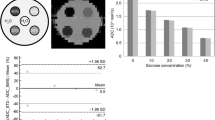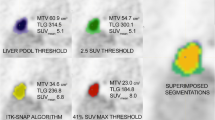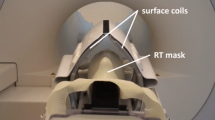Abstract
Objectives
To investigate the usefulness of voxel-based analysis of standardized uptake values (SUVs) and apparent diffusion coefficients (ADCs) for evaluating soft-tissue tumour malignancy with a PET/MR system.
Methods
Thirty-five subjects with either ten low/intermediate-grade tumours or 25 high-grade tumours were prospectively enrolled. Zoomed diffusion-weighted and fluorodeoxyglucose (18FDG)-PET images were acquired along with fat-suppressed T2-weighted images (FST2WIs). Regions of interest (ROIs) were drawn on FST2WIs including the tumour in all slices. ROIs were pasted onto PET and ADC-maps to measure SUVs and ADCs within tumour ROIs. Tumour volume, SUVmax, ADCminimum, the heterogeneity and the correlation coefficients of SUV and ADC were recorded. The parameters of high- and low/intermediate-grade groups were compared, and receiver operating characteristic (ROC) analysis was also performed.
Results
The mean correlation coefficient for SUV and ADC in high-grade sarcomas was lower than that of low/intermediate-grade tumours (−0.41 ± 0.25 vs. −0.08 ± 0.34, P < 0.01). Other parameters did not differ significantly. ROC analysis demonstrated that correlation coefficient showed the best diagnostic performance for differentiating the two groups (AUC 0.79, sensitivity 96.0%, specificity 60%, accuracy 85.7%).
Conclusions
SUV and ADC determined via PET/MR may be useful for differentiating between high-grade and low/intermediate-grade soft tissue tumours.
Key Points
• PET/MR allows voxel-based comparison of SUVs and ADCs in soft-tissue tumours.
• A comprehensive assessment of internal heterogeneity was performed with scatter plots.
• SUVmax or ADCminimum could not differentiate high-grade sarcoma from low/intermediate-grade tumours.
• Only the correlation coefficient between SUV and ADC differentiated the two groups.
• The correlation coefficient showed the best diagnostic performance by ROC analysis.





Similar content being viewed by others
References
Clark MA, Fisher C, Judson I, Thomas JM (2005) Soft-tissue sarcomas in adults. N Engl J Med 353:701–711
Fletcher CDM (2013) WHO Classification of tumours of soft tissue and bone: IARC Press
Fayad LM, Jacobs MA, Wang X, Carrino JA, Bluemke DA (2012) Musculoskeletal tumors: how to use anatomic, functional, and metabolic MR techniques. Radiology 265:340–356
De Schepper AM, De Beuckeleer L, Vandevenne J, Somville J (2000) Magnetic resonance imaging of soft tissue tumors. Eur Radiol 10:213–223
Zhao F, Ahlawat S, Farahani SJ et al (2014) Can MR imaging be used to predict tumor grade in soft-tissue sarcoma? Radiology 272:192–201
Charest M, Hickeson M, Lisbona R, Novales-Diaz JA, Derbekyan V, Turcotte R (2009) FDG PET/CT imaging in primary osseous and soft tissue sarcomas: a retrospective review of 212 cases. Eur J Nucl Med Mol Imaging 36:1944–1951
Bastiaannet E, Groen H, Jager PL et al (2004) The value of FDG-PET in the detection, grading and response to therapy of soft tissue and bone sarcomas; a systematic review and meta-analysis. Cancer Treat Rev 30:83–101
Schulte M, Brecht-Krauss D, Heymer B et al (2000) Grading of tumors and tumorlike lesions of bone: evaluation by FDG PET. J Nucl Med 41:1695–701
Aoki J, Watanabe H, Shinozaki T, Tokunaga M, Inoue T, Endo K (1999) FDG-PET in differential diagnosis and grading of chondrosarcomas. J Comput Assist Tomogr 23:603–8
Gibbs P, Liney GP, Pickles MD, Zelhof B, Rodrigues G, Turnbull LW (2009) Correlation of ADC and T2 measurements with cell density in prostate cancer at 3.0 Tesla. Investig Radiol 44:572–576
Koral K, Mathis D, Gimi B et al (2013) Common Pediatric Cerebellar Tumors: Correlation between Cell Densities and Apparent Diffusion Coefficient Metrics. Radiology 268:532–537
Del Grande F, Subhawong T, Weber K, Aro M, Mugera C, Fayad LM (2014) Detection of soft-tissue sarcoma recurrence: added value of functional MR imaging techniques at 3.0 T. Radiology 271:499–511
Dudeck O, Zeile M, Pink D et al (2008) Diffusion-weighted magnetic resonance imaging allows monitoring of anticancer treatment effects in patients with soft-tissue sarcomas. J Magn Reson Imaging 27:1109–1113
Wang X, Jacobs MA, Fayad L (2011) Therapeutic response in musculoskeletal soft tissue sarcomas: evaluation by MRI. NMR Biomed 24:750–763
Soldatos T, Ahlawat S, Montgomery E, Chalian M, Jacobs MA, Fayad LM (2016) Multiparametric assessment of treatment response in high-grade soft-tissue sarcomas with anatomic and functional MR imaging sequences. Radiology 278:831–840
Baba S, Isoda T, Maruoka Y et al (2014) Diagnostic and prognostic value of pretreatment SUV in 18F-FDG/PET in breast cancer: comparison with apparent diffusion coefficient from diffusion-weighted MR imaging. J Nucl Med 55:736–742
Regier M, Derlin T, Schwarz D et al (2012) Diffusion weighted MRI and 18F-FDG PET/CT in non-small cell lung cancer (NSCLC): does the apparent diffusion coefficient (ADC) correlate with tracer uptake (SUV)? Eur J Radiol 81:2913–2918
Preda L, Conte G, Bonello L et al (2016) Combining standardized uptake value of FDG-PET and apparent diffusion coefficient of DW-MRI improves risk stratification in head and neck squamous cell carcinoma. Eur Radiol 26:4432–4441
Sagiyama K, Watanabe Y, Kamei R, Baba S, Honda H (2016) Comparison of positron emission tomography diffusion-weighted imaging (PET/DWI) registration quality in a PET/MR scanner: Zoomed DWI vs Conventional DWI. J Magn Reson Imaging 43:853–858
Sagiyama K, Watanabe Y, Kamei R, Shinyama D, Baba S, Honda H (2016) An improved MR sequence for attenuation correction in PET/MR hybrid imaging. Magn Reson Imaging 34:345–352
Maes F, Collignon A, Vandermeulen D, Marchal G, Suetens P (1997) Multimodality image registration by maximization of mutual information. IEEE Trans Med Imaging 16:187–198
Viola P, Wells WM III (1997) Alignment by Maximization of Mutual Information. Int J Comput Vis 24:137–154
Helenius J, Soinne L, Perkio J et al (2002) Diffusion-weighted MR imaging in normal human brains in various age groups. AJNR Am J Neuroradiol 23:194–199
Maeda M, Maier SE, Sakuma H, Ishida M, Takeda K (2006) Apparent diffusion coefficient in malignant lymphoma and carcinoma involving cavernous sinus evaluated by line scan diffusion-weighted imaging. J Magn Reson Imaging 24:543–548
Youden WJ (1950) Index for rating diagnostic tests. Cancer 3:32–35
Schmidt H, Brendle C, Schraml C et al (2013) Correlation of simultaneously acquired diffusion-weighted imaging and 2-deoxy-[18F] fluoro-2-D-glucose positron emission tomography of pulmonary lesions in a dedicated whole-body magnetic resonance/positron emission tomography system. Investig Radiol 48:247–255
Donati OF, Mazaheri Y, Afaq A et al (2014) Prostate cancer aggressiveness: assessment with whole-lesion histogram analysis of the apparent diffusion coefficient. Radiology 271:143–152
Pope WB, Kim HJ, Huo J et al (2009) Recurrent glioblastoma multiforme: ADC histogram analysis predicts response to bevacizumab treatment. Radiology 252:182–189
Burger IA, Vargas HA, Apte A et al (2014) PET quantification with a histogram derived total activity metric: superior quantitative consistency compared to total lesion glycolysis with absolute or relative SUV thresholds in phantoms and lung cancer patients. Nucl Med Biol 41:410–418
Muzic RF, DiFilippo FP (2014) PET/MRI – Technical Review. Semin Roentgenol 49:242–54
Costelloe CM, Chuang HH, Madewell JE (2014) FDG PET/CT of primary bone tumors. AJR Am J Roentgenol 202:W521–W531
Iima M, Le Bihan D (2016) Clinical intravoxel incoherent motion and diffusion MR imaging: past, present, and future. Radiology 278:13–32
Heusch P, Buchbender C, Beiderwellen K et al (2013) Standardized uptake values for [18F] FDG in normal organ tissues: comparison of whole-body PET/CT and PET/MRI. Eur J Radiol 82:870–876
Author information
Authors and Affiliations
Corresponding author
Ethics declarations
Guarantor
The scientific guarantor of this publication is Yuji Watanabe
Conflict of interest
The authors of this manuscript declare relationships with the following companies: Y. Watanabe and S. Kawanami: Bayer Healthcare Japan, Modest, Research Grant; Philips Electronics Japan, Modest, Research Grant.
Funding
This study received funding by JSPS KAKENHI Grant Number JP16K19827 and the Fukuoka Foundation for Sound Health Cancer Research Fund.
Statistics and biometry
No complex statistical methods were necessary for this paper.
Informed consent
Written informed consent was obtained from all subjects (patients) in this study.
Ethical approval
Institutional Review Board approval was obtained.
Methodology
• prospective
• diagnostic
• performed at one institution
Rights and permissions
About this article
Cite this article
Sagiyama, K., Watanabe, Y., Kamei, R. et al. Multiparametric voxel-based analyses of standardized uptake values and apparent diffusion coefficients of soft-tissue tumours with a positron emission tomography/magnetic resonance system: Preliminary results. Eur Radiol 27, 5024–5033 (2017). https://doi.org/10.1007/s00330-017-4912-y
Received:
Revised:
Accepted:
Published:
Issue Date:
DOI: https://doi.org/10.1007/s00330-017-4912-y




